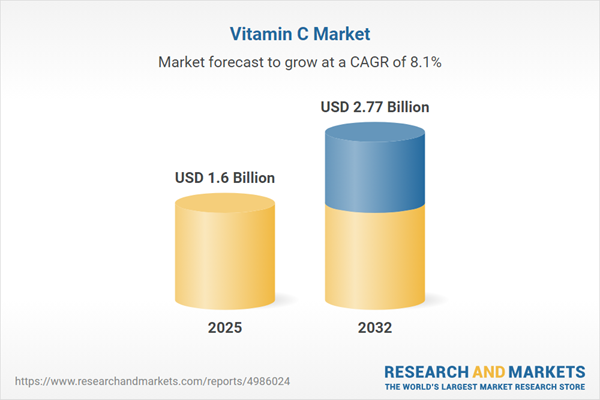Speak directly to the analyst to clarify any post sales queries you may have.
Senior leaders in the vitamin C ingredient market are navigating a landscape of regulatory change, shifting consumer preferences, and dynamic supply challenges. In this complex environment, actionable market intelligence enables proactive risk management and sustained business growth.
Market Snapshot: Vitamin C Ingredient Market Outlook
The vitamin C ingredient market is valued at USD 1.48 billion and is projected to reach USD 1.60 billion by 2025, with a compound annual growth rate (CAGR) of 8.14%.
Industry growth is closely linked to investments in operational efficiency, digital optimization of logistics operations, and strategic innovation across both emerging and established segments. Market participants including manufacturers, distributors, and B2B buyers are adopting adaptive commercial models that drive responsiveness to rapid industry changes and enhance value creation. These strategies place companies in a stronger position to address complex supply chain risks and regulatory shifts while supporting sustainable competitive advantage as the market evolves.Scope & Segmentation: Vitamin C Ingredient Market Analysis
- Product Forms: Capsules, effervescent tablets, chewables, powder sachets, film-coated formats, syrup, and injectable types enable tailored solutions for pharmaceutical, nutraceutical, and food industry partners.
- Applications: Incorporation in cosmetics, dietary supplements, as well as functional food and beverage markets, allows brand owners to differentiate products for preventative, wellness, healthcare, and therapeutic solutions.
- Sources: Natural ingredients such as acerola cherry and camu camu, alongside synthetic varieties, help organizations meet regulations, align with transparency targets, and refine procurement strategies to suit customer needs.
- Distribution Channels: Utilization of pharmacies, supermarkets, and digital platforms broadens B2B engagement and fosters strong connections with both retailers and channel partners across diverse markets.
- Vitamin C Types: The supply chain covers ascorbic acid, calcium ascorbate, Ester-C, and sodium ascorbate, supporting clinical, nutrition, and operational objectives for buyers.
- Regional Coverage: North America, Europe, Middle East and Africa, Asia-Pacific, and the Americas offer unique compliance frameworks and distinct buyer priorities. Strategic approaches are needed to meet regional trends and ensure regulatory excellence.
- Leading Companies: Key industry players include Koninklijke DSM N.V., BASF SE, North China Pharmaceutical Group, Shandong Luwei Pharmaceutical, Zhejiang Medicine, DSM Nutritional Products, Hefei TNJ Chemical Industry, Tianjin Northeast Pharmaceutical Group, Northeast Pharmaceutical Group, and Hubei Grand Pharmaceutical, all shaping industry reliability and standards.
Key Takeaways for Strategic Positioning
- Liquid and portable packaging advances make vitamin C products more accessible and reduce time-to-market, reaching a broader range of B2B customers.
- Enhanced extraction and stabilization technologies help maintain product performance, enabling specialized ingredient formats that serve both clinical and consumer requirements.
- Procurement teams are reorganizing sourcing processes to meet clean-label and ethical expectations, boosting transparency and improving relationships with B2B partners.
- Collaboration between manufacturers, brands, and distributors strengthens differentiation, particularly in cosmeceutical, functional food, and nutrition-centric markets.
- North America focuses on improving market access, Asia-Pacific targets efficient distribution networks, and Europe maintains strict regulatory controls for product innovation.
- Organizations are reinforcing dealer and supplier networks by emphasizing nearshoring and building regionally focused partnerships to secure supply continuity amid global uncertainties.
Tariff Impact: Sourcing and Supply Chain Evolution
Recent tariffs imposed on raw materials in the United States have encouraged decision-makers to prioritize increasing domestic capacity and diversify supplier networks. These moves are designed to protect continuity of supply against policy changes, strengthen regional supplier relationships, and support a balanced approach between natural and synthetic vitamin C sourcing to reduce external risks.
Methodology & Data Sources
The analysis relies on proprietary datasets, validated financial reviews, real-time trends, and patent research. Continuous consultation with executive and technical stakeholders ensures the research remains practical and immediately relevant for supply chain and enterprise planning.
Why This Report Matters for Senior Decision-Makers
- Identifies vital market trends and innovation patterns for navigating vitamin C ingredient sourcing and procurement risks.
- Supports operational resilience with timely regulatory analysis and evidence-based frameworks for agile, real-time business decisions.
- Offers actionable insights to guide investment, market entry, and alignment with corporate goals amid shifting regional dynamics.
Conclusion
Sustained success in the vitamin C ingredient market requires rigorous market intelligence, vigilant trend assessment, and adaptive strategies to support competitiveness and long-term organizational growth.
Additional Product Information:
- Purchase of this report includes 1 year online access with quarterly updates.
- This report can be updated on request. Please contact our Customer Experience team using the Ask a Question widget on our website.
Table of Contents
3. Executive Summary
4. Market Overview
7. Cumulative Impact of Artificial Intelligence 2025
Companies Mentioned
The companies profiled in this Vitamin C market report include:- Koninklijke DSM N.V.
- BASF SE
- Northeast Pharmaceutical Group Co., Ltd.
- Hefei TNJ Chemical Industry Co., Ltd.
- Hubei Grand Pharmaceutical Co., Ltd.
- Zhejiang Medicine Co., Ltd.
- DSM Nutritional Products
- Tianjin Northeast Pharmaceutical Group
- North China Pharmaceutical Group Corporation
- Shandong Luwei Pharmaceutical Co., Ltd
Table Information
| Report Attribute | Details |
|---|---|
| No. of Pages | 188 |
| Published | October 2025 |
| Forecast Period | 2025 - 2032 |
| Estimated Market Value ( USD | $ 1.6 Billion |
| Forecasted Market Value ( USD | $ 2.77 Billion |
| Compound Annual Growth Rate | 8.1% |
| Regions Covered | Global |
| No. of Companies Mentioned | 11 |









